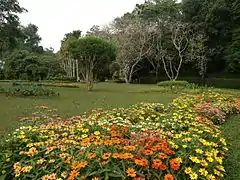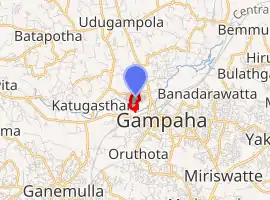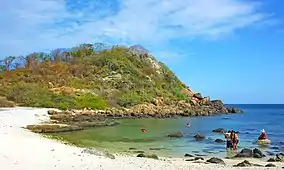Henarathgoda Botanical Garden
Henarathgoda Botanical Garden is one of the six botanical gardens in Sri Lanka. The botanical garden is situated on the Gampaha-Minuwangoda main road, approximately 450 m (1,480 ft) away from Gampaha railway station. It is about 29 km (18 mi) from Sri Lanka's commercial capital of Colombo.[1][2]
| Henarathgoda Botanical Garden | |
|---|---|
 | |

| |
| Type | Botanical garden |
| Location | Gampaha, Sri Lanka |
| Coordinates | 7°06′00″N 79°59′10″E |
| Area | 17.8ha |
| Elevation | 10m |
| Created | 1876 |
| Operated by | Department of National Botanic Gardens, Sri Lanka |
| Status | Open all year |
| Plants | 2,000 (Appx:) |
| Species | 400 (Appx:) |
| Part of a series on |
| Wildlife of Sri Lanka |
|---|
 |
History
In 1825 Governor Edward Barnes planted an extensive garden at this location, on the banks of the Kelani River.[3]
During the 19th Century British naturalists made various studies about botany along with other sciences. One of their interests was the finding of possibility of establishing rubber yielding plants in Asia. They planted various rubber yielding plants both in India and Ceylon, including Para rubber (Hevea brasiliensis), Gutta percha (Palaquium gutta), Panama rubber (Castilea elastica), Balatta (Mimusops globesa) and Lagos (Funtumia elastica). The British naturalists concentrated their trials to Ceylon due to the failure of rubber trials in India and discovered that Ceylon offers the same environmental condition as that of the Amazon.
In 1876, 1,919 rubber seedlings, collected from the Amazon forest, were imported from the Royal Botanic Gardens, Kew and planted at the Gampaha gardens, under the guidance of George Thwaites, the superintendent of the botanical gardens at Peradeniya.[4] These rubber plants bloomed for the first time in 1881 and seeds obtained from them were exported to South India, Malaysia, and Myanmar. In 1919 the world first rubber exhibition was held at the Royal Botanical Gardens, Peradeniya.
At these times the garden was laid out and managed by Muhandiram Amaris De Zoysa under the supervision of the director of the Royal Botanic Gardens, Peradeniya.[5] The oldest rubber tree in the gardens collapsed following a severe rain storm in 1988 and the remaining trees are now preserved as a national monument of the country.[6]
The Garden
The altitude of garden is about 10 m (33 ft) above the sea level. It has a tropical low-country climate. The total area of the botanical garden is about 15 ha (37 acres) and recently it acquired another 2.8 ha (6.9 acres) for its expansion.
References
- http://www.ceylonlanka.info/2012/02/gampaha-henarathgoda-botanical-garden.html
- http://www.gic.gov.lk/gic/index.php?option=com_info&id=1451&task=info&lang=en
- Juriansz, Allan Russell (2013). Colonial Mixed Blood: A Story of the Burghers of Sri Lanka. p. 202. ISBN 9781491713655.
- Oldfield, Sarah (2007). Great Botanic Gardens of the World. New Holland. p. 90. ISBN 9781845375935.
- "The Gardeners Chronicle and Horticultural Trade Journal". 17. London. 1895: 489. Cite journal requires
|journal=(help) - "Gampaha Botanic Garden - Botanic Gardens Conservation International".
External links
| Wikimedia Commons has media related to Henarathgoda Botanical Garden. |